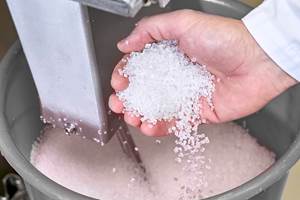Asahi Kasei Aims for ‘First-to-Market’ of a More Sustainable Nylon 66
In addition, Asahi Kasei Plastics North America (APNA) is on a roll with its expanded Leona portfolio of specialty nylon 66-based compounds.
Vertically integrated with parent company, compounder of specialty, high-performance, engineered polymers such a nylon 66-based, PPE, and chemically-coupled PP, Asahi Kasei Plastics North America (APNA) is developing and launching new engineered compounds for automotive applications, particularly for the electrification of automobiles.
Moreover, parent company Asahi Kasei Corporation is developing more sustainable versions of its innovative compounds through industry partnerships. As we have previously reported, it has teamed up with biotechnology firm Genomatica to commercialize renewably-sourced nylon 66. The partnership entails the use of Genomatica’s biobased HMD (hexamethylenediamine, also abbreviated as HMDA) building block. Genomatica has been able to change the DNA on certain bacteria so that they produce HMD after ‘eating’ sugars that do not disrupt the food chain in any way. Currently, HMD accounts for roughly half of the makeup of Leona nylon compounds, making this a significant step towards sustainability.
Asahi Kasei sees this collaboration as key to supporting its goal to be first-to-market with a more sustainable nylon 66 for the automotive and electronics industries, utilizing bio-HMD, and to accelerate the achievement of its corporate sustainability objectives. Asahi Kasei Corporation has preferential access to early volumes of renewably-sourced HMD and nylon application testing, leveraging the company’s expertise in developing successful nylon applications for use in products such as high-temperature automotive parts, electronics, or yarns to produce airbags. Asahi Kasei will have the opportunity to license Genomatica’s Geno HMD process technology to commercialize biobased nylon 66 once the technology is completed. While timetables are not currently being disclosed, Asahi Kasei is confident that its nylon-66 made with bio-HMD will have all the same quality and performance as it does now.

Meanwhile, I recently had the pleasure to interview industry veteran Todd Glogovsky, president and COO of APNA. Glogovsky has over 25 years of experience in the plastics industry supporting technology, sales and marketing. Prior to his current role, Glogovsky was a managing director at LyondellBasell, and he also worked at Bayer. We discussed some of the latest key technology offerings launched and under development.
Included is last year’s launch of a series of halogen-free and red-phosphorus-free flame-retardant nylon 66 resins targeted to E&E applications such as breakers, magnet switches, and compressed-air valves as well as automotive applications in powertrain parts and EV charging stations. The new Leona SN series is part of the company’s Leona nylon resin portfolio which also includes the standard Leona 14G series of anti-ultraviolet nylon 66 compounds, and the special semi-aromatic Leona 90G series (a combination of nylon 66 and 6I aromatic nylon) for use in replacing metals in automotive and industrial applications. Both these series are produced with high glass content. Glogovsky notes that Leona SG compounds with high-glass content (60%) continue to replace cast metals in high-pressure, high-strength areas and beyond automotive, such as window latches.
The new halogen-free SN series resins boast UL 94 V-0 and relative tracking index (CTI) of 600 V, good surface appearance, good laser transparency (Na) and laser printability (BK). Also claimed are enhanced productivity thanks to clearer and faster laser marking on gloss surfaces, and less mold deposit than conventional halogen-free and red-phosphorus-free materials. Moreover, although the properties of similar halogen-free nylon 66 materials are significantly reduced, Leona SN compounds can still maintain a high level of tensile strength and flexural modulus after moisture absorption.
Glogovsky sees all of APNA’s flame-retardant offerings as promising contenders for expanded use in electric vehicle battery applications, noting that the EV industry is very dynamic with a lot of learning taking place. “In such battery applications, ranging from highly structured components to lighter ones, you need all of these--nylon for its high temperature resistance, PPE for its strength and dimensional stability, and PP for its chemical resistance and lower pricing.”
Related Content
Tracing the History of Polymeric Materials, Part 26: High-Performance Thermoplastics
The majority of the polymers that today we rely on for outstanding performance — such as polysulfone, polyethersulfone, polyphenylsulfone and PPS — were introduced in the period between 1965 and 1985. Here’s how they entered your toolbox of engineering of materials.
Read MoreICIS Launches: Ask ICIS Generative AI Commodities Assistant
Said to be the first of its kind, this AI assistant will enhance access to ICIS’ intelligence and insights for the energy and chemical markets.
Read MoreSoft Prices for Volume Resins
While PP and PE prices may be bottoming out, a downward trajectory was likely for all other volume resins, including engineering types.
Read MorePrices Bottom Out for Volume Resins?
Flat-to-down trajectory underway for fourth quarter for commodity resins.
Read MoreRead Next
For PLASTICS' CEO Seaholm, NPE to Shine Light on Sustainability Successes
With advocacy, communication and sustainability as three main pillars, Seaholm leads a trade association to NPE that ‘is more active today than we have ever been.’
Read MoreMaking the Circular Economy a Reality
Driven by brand owner demands and new worldwide legislation, the entire supply chain is working toward the shift to circularity, with some evidence the circular economy has already begun.
Read MoreSee Recyclers Close the Loop on Trade Show Production Scrap at NPE2024
A collaboration between show organizer PLASTICS, recycler CPR and size reduction experts WEIMA and Conair recovered and recycled all production scrap at NPE2024.
Read More


























